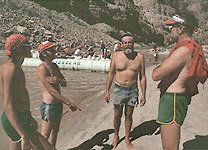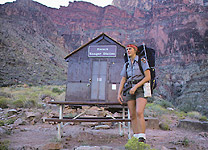
Ultimate Grand Canyon Backpack (Cont'd)
(Page 5 of 9)

 Our next destination, Olo Canyon, was where Canyoneers would make their second and final food drop. Their river running season would be finished then and they had reliably supplied us through some of the most remote regions of the Grand Canyon. Only one boat greeted us at Olo but they came for lunch bringing both our supplies and a scrumptious river buffet to which we were invited as the guests of honor. We became minor celebrities as most of the river party circled about us with barrages of questions about our activities from Diamond Creek to Olo. It amused us that their trip would soon be ending but ours was only a third completed. No unknown obstacles lay in front of us but a monumental effort would still be required to reach our Lee's Ferry destination. These boat people had only to sit back and enjoy the scenery which we had so laboriously crossed and within two to three days they would be on their way home. What a contrast in commitment!
Our next destination, Olo Canyon, was where Canyoneers would make their second and final food drop. Their river running season would be finished then and they had reliably supplied us through some of the most remote regions of the Grand Canyon. Only one boat greeted us at Olo but they came for lunch bringing both our supplies and a scrumptious river buffet to which we were invited as the guests of honor. We became minor celebrities as most of the river party circled about us with barrages of questions about our activities from Diamond Creek to Olo. It amused us that their trip would soon be ending but ours was only a third completed. No unknown obstacles lay in front of us but a monumental effort would still be required to reach our Lee's Ferry destination. These boat people had only to sit back and enjoy the scenery which we had so laboriously crossed and within two to three days they would be on their way home. What a contrast in commitment!
Reprovisioned, Bob and I trudged on. Trudge is the correct word when your pack bulges with fourteen days of food and the camera gear required to document such a trip. We had significantly improved our physical condition by this time and each new cache location found us better prepared to walk away with the necessary supplies. Day after day we followed a pattern of rising early to take advantage of the cool early morning, resting two to three hours at mid-day to escape the directly-overhead, fiery sun, and then continuing in the afternoon to that day's destination. Fortunately, we found that this pattern resulted in the best opportunities to photograph our inner canyon home. Our rests across from Kanab Creek and Deer Creek Falls, at Elves Chasm, and near the Tonto Trail at Bass Rapid were especially memorable.
 While the Tonto Trail made our walking considerably easier, it unfortunately meandered around many side canyons from Garnet Canyon to Hance Canyon. We would walk over 90 miles of primitive trail to advance 40 river miles upstream. The weather remained hot into early October and water was hard to find on this plateau, particularly between Bass Canyon and Boucher. During the 110° F heat of one of these long blistering days, both Bob and I consumed two and a half gallons of water. This left us desperate for more that evening and relying solely upon our wits to find an improbable seep or spring. Progress on this harsh, exposed plateau in the wicked heat was frequently limited by our ability to find, carry, and consume huge quantities of water.
While the Tonto Trail made our walking considerably easier, it unfortunately meandered around many side canyons from Garnet Canyon to Hance Canyon. We would walk over 90 miles of primitive trail to advance 40 river miles upstream. The weather remained hot into early October and water was hard to find on this plateau, particularly between Bass Canyon and Boucher. During the 110° F heat of one of these long blistering days, both Bob and I consumed two and a half gallons of water. This left us desperate for more that evening and relying solely upon our wits to find an improbable seep or spring. Progress on this harsh, exposed plateau in the wicked heat was frequently limited by our ability to find, carry, and consume huge quantities of water.
Food had become a minor problem, as our original plan had a resupply point at Havasu Creek and we had inadvertently omitted four days of food. The NPS, along with Gary Casey's Wilderness World group, came to our rescue. Welcome quantities of peanut butter, bread, and other goodies were offered by Gary at Dubendorff Rapid and by the NPS at Bass Rapid. Their generosity assured us of adequate calories every day to Hermit Camp. The seasonal ranger, Carolyn Groome, stationed at Hermit Creek invited us to dinner one evening and then generously gave us a couple of days of her food, which she was required to carry in, to tide us over until our resupply group came down the Hermit Trail. Since we arrived two days early, we enjoyed this bonus time visiting with other hikers, resting, and preparing ourselves for the 96 river miles of river corridor that still lay ahead.
[first page | previous page | next page | last page].

Updated on Thursday, November 3, 2011 @ 4:30 MST
© 1995-2011 by Robert R. Marley |
 Our next destination, Olo Canyon, was where Canyoneers would make their second and final food drop. Their river running season would be finished then and they had reliably supplied us through some of the most remote regions of the Grand Canyon. Only one boat greeted us at Olo but they came for lunch bringing both our supplies and a scrumptious river buffet to which we were invited as the guests of honor. We became minor celebrities as most of the river party circled about us with barrages of questions about our activities from Diamond Creek to Olo. It amused us that their trip would soon be ending but ours was only a third completed. No unknown obstacles lay in front of us but a monumental effort would still be required to reach our Lee's Ferry destination. These boat people had only to sit back and enjoy the scenery which we had so laboriously crossed and within two to three days they would be on their way home. What a contrast in commitment!
Our next destination, Olo Canyon, was where Canyoneers would make their second and final food drop. Their river running season would be finished then and they had reliably supplied us through some of the most remote regions of the Grand Canyon. Only one boat greeted us at Olo but they came for lunch bringing both our supplies and a scrumptious river buffet to which we were invited as the guests of honor. We became minor celebrities as most of the river party circled about us with barrages of questions about our activities from Diamond Creek to Olo. It amused us that their trip would soon be ending but ours was only a third completed. No unknown obstacles lay in front of us but a monumental effort would still be required to reach our Lee's Ferry destination. These boat people had only to sit back and enjoy the scenery which we had so laboriously crossed and within two to three days they would be on their way home. What a contrast in commitment!
 While the Tonto Trail made our walking considerably easier, it unfortunately meandered around many side canyons from Garnet Canyon to Hance Canyon. We would walk over 90 miles of primitive trail to advance 40 river miles upstream. The weather remained hot into early October and water was hard to find on this plateau, particularly between Bass Canyon and Boucher. During the 110° F heat of one of these long blistering days, both Bob and I consumed two and a half gallons of water. This left us desperate for more that evening and relying solely upon our wits to find an improbable seep or spring. Progress on this harsh, exposed plateau in the wicked heat was frequently limited by our ability to find, carry, and consume huge quantities of water.
While the Tonto Trail made our walking considerably easier, it unfortunately meandered around many side canyons from Garnet Canyon to Hance Canyon. We would walk over 90 miles of primitive trail to advance 40 river miles upstream. The weather remained hot into early October and water was hard to find on this plateau, particularly between Bass Canyon and Boucher. During the 110° F heat of one of these long blistering days, both Bob and I consumed two and a half gallons of water. This left us desperate for more that evening and relying solely upon our wits to find an improbable seep or spring. Progress on this harsh, exposed plateau in the wicked heat was frequently limited by our ability to find, carry, and consume huge quantities of water.